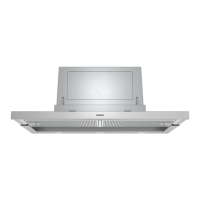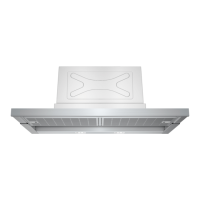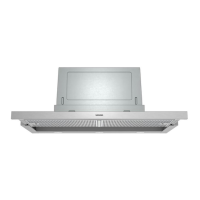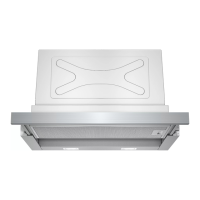en Installation instructions
12
room-air-dependent heat-producing appli-
ance is being operated.
▶ It is only possible to safely operate the ap-
pliance if the pressure in the room in which
the heating appliance is installed does not
fall below 4Pa(0.04mbar). This can be
achieved whenever the air needed for com-
bustion is able to enter through openings
that cannot be sealed, for example in
doors, windows, incoming/exhaust air wall
boxes or by other technical means. An in-
coming/exhaust air wall box alone is not
sufficient to ensure compliance with the
limit.
▶ In any case, consult your responsible chim-
ney sweep. They are able to assess the
house's entire ventilation setup and will
suggest the suitable ventilation measures
to you.
▶ Unrestricted operation is possible if the ap-
pliance is operated exclusively in circulat-
ing-air mode.
Risk of poisoning from flue gases being
drawn back in.
▶ If an extractor hood with an open-flued heat
production source is installed, the power
supply for the extractor hood must be
provided with a suitable safety switch.
Risk of poisoning from flue gases being
drawn back in.
▶ Do not emit the exhaust air into a smoke or
exhaust gas flue that is in operation.
▶ Do not emit the exhaust air into a shaft that
is used to ventilate installation rooms for
heat-producing appliances.
▶ If the exhaust air is to be conveyed into a
smoke or exhaust gas flue, you must obtain
the consent of the heating engineer re-
sponsible.
WARNING‒Risk of suffocation!
Children may put packaging material over
their heads or wrap themselves up in it and
suffocate.
▶ Keep packaging material away from chil-
dren.
▶ Do not let children play with packaging ma-
terial.
WARNING‒Risk of fire!
The grease deposits in the grease filter may
catch fire.
▶ Never work with naked flames close to the
appliance (e.g. flambéing).
▶ Do not install the appliance near a heat-
producing appliance for solid fuel (e.g.
wood or coal) unless a closed, non-remov-
able cover is present. There must be no fly-
ing sparks.
▶ The specified safety clearances must be
complied with in order to prevent a build-up
of heat.
▶ Observe the specifications for your cooking
appliances. If the installation instructions for
the cooking appliances specify a different
clearance, the larger of the two must al-
ways be provided for. If gas hobs and elec-
tric hobs are operated together, the largest
specified clearance applies.
WARNING‒Risk of injury!
Components inside the appliance may have
sharp edges.
▶ Wear protective gloves.
The appliance may fall down if it has not been
properly fastened in place.
▶ All fastening components must be fixed
firmly and securely in place.
Changes to the electrical or mechanical as-
sembly are dangerous and may lead to mal-
functions.
▶ Do not make any changes to the electrical
or mechanical assembly.
WARNING‒Risk of electric shock!
Sharp-edged components inside the appli-
ance may damage the connecting cable.
▶ Do not kink or trap the connecting cable.
If the appliance or the power cord is dam-
aged, this is dangerous.
▶ Never operate a damaged appliance.
▶ Never pull on the power cord to unplug the
appliance. Always unplug the appliance at
the mains.
▶ If the appliance or the power cord is dam-
aged, immediately unplug the power cord
or switch off the fuse in the fuse box.
▶ Call customer services. →Page10
Improper repairs are dangerous.
▶ Repairs to the appliance should only be
carried out by trained specialist staff.
▶ Only use genuine spare parts when repair-
ing the appliance.
▶ If the power cord of this appliance is dam-
aged, it must be replaced by the manufac-
turer, the manufacturer's Customer Service
or a similarly qualified person in order to
prevent any risk.

